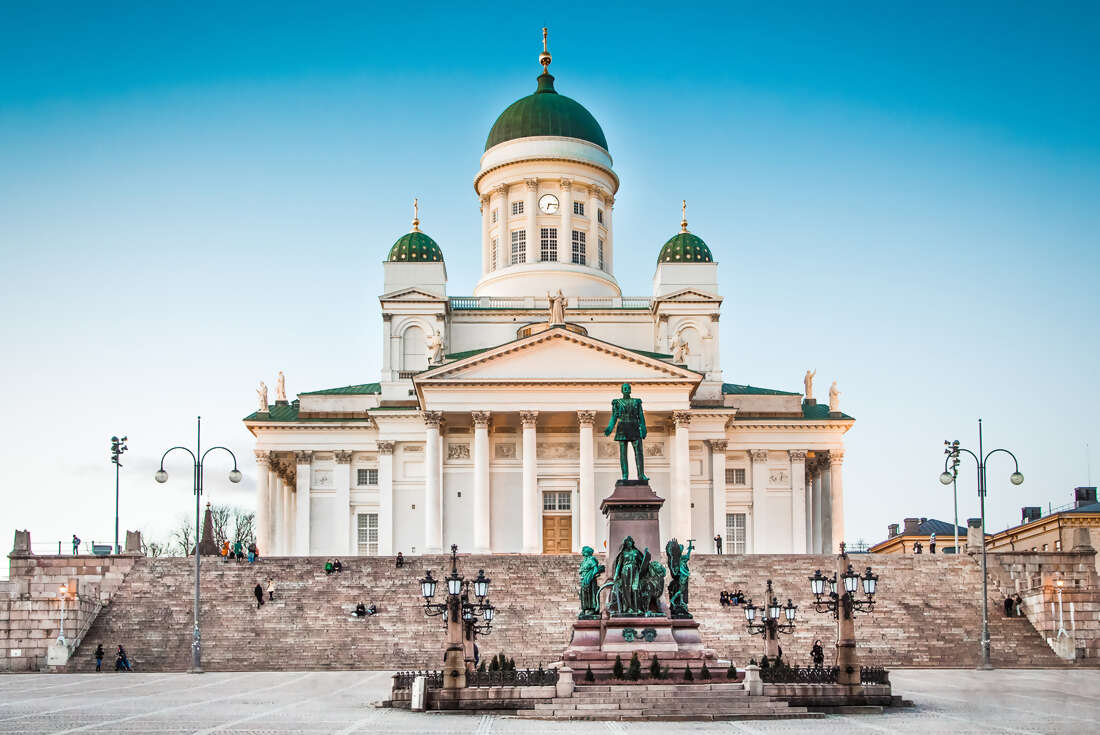 Discover the many charms of Europe on this enriching northern adventure. Tour from Oslo to Vilnius, visiting Norway, Sweden, Finland, Estonia, Latvia and Lithuania, and all the countryside in between. Travel through some of Europe's most stylish capitals and be wowed by some of the world's most striking waterways. Along the way, uncover a Viking past, learn of a maritime heritage and be immersed in vibrant art and classic architecture. Whether it's walking along charming streets in Bergen, sailing through vast fjords or indulging in the delights of hearty northern cuisine, you'll undoubtedly be left with a tonne of memories from this once-in-a-lifetime European adventure.
Discover the many charms of Europe on this enriching northern adventure. Tour from Oslo to Vilnius, visiting Norway, Sweden, Finland, Estonia, Latvia and Lithuania, and all the countryside in between. Travel through some of Europe's most stylish capitals and be wowed by some of the world's most striking waterways. Along the way, uncover a Viking past, learn of a maritime heritage and be immersed in vibrant art and classic architecture. Whether it's walking along charming streets in Bergen, sailing through vast fjords or indulging in the delights of hearty northern cuisine, you'll undoubtedly be left with a tonne of memories from this once-in-a-lifetime European adventure. Highlights
Norway's fjords feature some of the most stunning scenery on Earth. Cruise past waterfalls and snow-capped peaks through the narrow (and aptly-named) Naeroyfjord.
Discover Stockholm's maritime history at the Vasa Museum, which houses an original wooden war ship from 1628. This impressive vessel gives you a rare glimpse into the naval power Sweden was once famous for.
Explore 13th-century Turaida Castle on a guided tour, then wander through pristine woodlands and along the winding Guaja River.
Aukstaitija National Park offers unique opportunities for both action and relaxation. Kayak across pristine lakes, indulge in home-cooked meals or cleanse yourself in a traditional sauna.
See the whimsical and ornate architecture of Riga’s Old Town, where the narrow and pastel-coloured buildings house bars and restaurants.







- You will visit the following places:
-

Oslo
Oslo is a county and municipality, as well as the capital and largest city in Norway. Oslo was established as a municipality on 1 January 1838. Founded around 1048 by King Harald III "Hardraade" of Norway, the city was largely destroyed by fire in 1624. The Danish–Norwegian king Christian IV moved the city, rebuilding it closer to Akershus fortress, as Christiania (briefly also spelt Kristiania). In 1925, the city reclaimed its original Norwegian name, Oslo. The diocese of Oslo is one of the five original dioceses in Norway, which originated around the year 1070.
-

Bergen
Bergen is the second largest city in Norway with a population of 261,600 as of April 31, 2011. Bergen is the administrative centre of Hordaland county. Greater Bergen or Bergen Metropolitan Area as defined by Statistics Norway, has a population of 386,900 as of April 31, 2011. Bergen is located in the county of Hordaland on the south-western coast of Norway. It is an important cultural hub in its region, recognized as the unofficial capital of Western Norway and sometimes also referred to as the Atlantic coast capital of Norway. The city was one of nine European cities honoured with the title of European Capital of Culture in the Millennium year.
-

Stockholm
Stockholm - Sweden's capital and largest city, and the most populous city in the Nordic region. Without a doubt, Stockholm is one of the most beautiful cities in Europe. The city is made up of 14 islands connected by some 50 bridges on Lake Mälaren, which flows into the brackish Baltic Sea, and passes the Stockholm archipelago with some 24,000 islands and islets. The city is a cosmopolitan place with both classical and modern architecture, and a captivating Old Town, Gamla Stan. Today, the area is an atmospheric mixture of buildings surrounded on all sides by a latticework of medieval lanes and alleyways.
-

Helsinki
Helsinki is the capital and largest city in Finland. Finland's major political, educational, financial, cultural, and research center as well as one of northern Europe's major cities, Helsinki was ranked the most liveable city in the world, in 2011. Approximately 75% of foreign companies operating in Finland have settled in the Helsinki region. The nearby municipality of Vantaa is the location of Helsinki Airport, with frequent service to various destinations in Europe and Asia. Today, Helsinki pulls off the trick of being something of an international metropolis while still retaining a small-town feel. The best time to visit is in summer, when Finns peel off their overcoats and flock to outdoor bars and cafes to enjoy the sunshine.
-

Tallinn
Tallinn is the capital and largest city of Estonia. It occupies an area of 159.2 km2 (61.5 sq mi) with a population of 412,144. It is situated on the northern coast of the country, on the banks of the Gulf of Finland, 80 km (50 mi) south of Helsinki, east of Stockholm and west of Saint Petersburg. Tallinn's Old Town is in the list of UNESCO World Heritage Sites. Tallinn is ranked as a global city and has been listed among the top 10 digital cities in the world. Tallinn is a European Capital of Culture for 2011, along with Turku, Finland.
-

Riga
Riga is the capital and largest city of Latvia, a major industrial, commercial, cultural and financial centre of the Baltics, and an important seaport, situated on the mouth of the Daugava. With 706,413 inhabitants (2010) it is the largest city of the Baltic states. Riga's territory covers 18.60 square miles and lies between 1 and 10 metres (3.3 and 33 ft) above sea level, on a flat and sandy plain. Riga's historical centre has been declared a UNESCO World Heritage Site, and the city is particularly notable for its extensive Jugendstil (German Art Nouveau) architecture, which UNESCO considers to be unparalleled anywhere in the world.
-

Vilnius
Vilnius is the capital of Lithuania, and its largest city, with a population of 560,190 as of 2010. It is the seat of the Vilnius city municipality and of the Vilnius district municipality. It is also the capital of Vilnius County. Vilnius is a cosmopolitan city with diverse architecture. There are 65 churches in Vilnius. Aušros Vartai Street. The icon of The Virgin Mary, Mother of Mercy is venerated in a chapel at the medieval gate at the top of this street. Like most medieval towns, Vilnius was developed around its Town Hall. The main artery, Pilies Street, links the Royal Palace with Town Hall. Other streets meander through the palaces of feudal lords and landlords, churches, shops and craftsmen's workrooms.